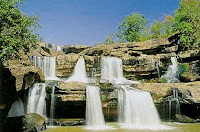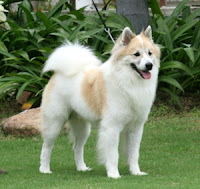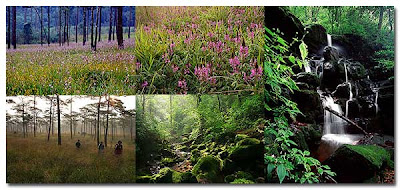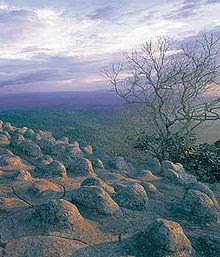Phitsanulok {พิษณุโลก} is a provinces of Thailand, located in the north. Neighboring provinces are Loei, Phetchabun, Phichit, Kamphaeng Phet, Sukhothai, Uttaradit.
Most of Phitsanulok has a hot tropical climate with considerable annual rainfall (annual rainfall is approximately 1.8 meters). In the higher altitude regions of the province, however, the climate is cool, with temperatures peaking at around 25? Celsius, sometimes dropping below the freezing point. With regard to rainfall, there is a dry season and a rainy season. The rainy season begins in the spring and ends around November.
Phitsanulok is home to a plethora of animal and plant species, including a number of endangered species, vulnerable species and near threatened species. Indigenous animal species include a variety of mammals (including endangered tigers and the vulnerable asiatic black bear), crabs, reptiles, amphibians, fish, insects, and over 190 species of birds. Indigenous plant life include numerous species of flowering plants including the endangered phayom.
Phitsanulok is located north and lower in the central region of the upper part of Thailand . Miles of roads and 320 km with a total area about 10,815 square kilometers. Population totaled 845,561 persons are male 415,593 females 429,968 people.
- The provincial flower is the Yellow Flamboyant (Peltophorum pterocarpum).
- The provincial tree is the Millingtonia hortensis.
- The seal of the province shows the Buddha Chinnarat, which is considered one of the most beautiful Buddha figures in Thailand.

Adminstrative divisions.
The province is 9 districts. These are subdivided into 93 communes. and 993 muban, which are administrative divisions at the village level.
- Mueang Phitsa. - Nakhon Thai.
- Chat Trakan. - Bang Rakam.
- Bang Krathum. - Phrom Phiram.
- Wat Bot. - Wang Thong.
- Noen Maprang.
- Bang Krathum. - Phrom Phiram.
- Wat Bot. - Wang Thong.
- Noen Maprang.
Tourism Sights.
Phu Soi Dao National Park {อุทยานแห่งชาติภูสอยดาว} Bordering Thailand and Lao PDR with rugged mountains, the park has Phu Soi Dao as the highest peak towering at 2,102 metres. Its attractions include coniferous forest, a flower field, viewpoint cliff, Namtok Sai Thip and Namtok Phu Soi Dao.
Textile Museum and Life Museum {พิพิธภัณฑ์ผ้า และพิพิธภัณฑ์ชีวิต} displays textiles and garments from different sources domestically and internationally. Nearby is a Life Museum that displays the Thai way of cotton weaving.
 Town Wall and Moat {กำแพงเมืองคูเมือง} It was built during the reign of King Borommatrailokkanat of Ayutthaya to prevent the attack of Lanna troops. Today's, remains of the old wall can be seen at Wat Phothiyan, Wat Noi, the Police Station, and the moat along the Phra Ruang Road.
Town Wall and Moat {กำแพงเมืองคูเมือง} It was built during the reign of King Borommatrailokkanat of Ayutthaya to prevent the attack of Lanna troops. Today's, remains of the old wall can be seen at Wat Phothiyan, Wat Noi, the Police Station, and the moat along the Phra Ruang Road. King Naresuan the Great’s Shrine {ศาลสมเด็จพระนเรศวรมหาราช} The ancient-style three-portico pavilion designed by the Fine Arts Department houses a life-size statue of the king in a sitting posture, declaring independence from Burma.
City Pillar Shrine {เสาหลักเมืองพิษณุโลก} Designed by the Fine Arts Department, the Prang-shaped building houses the city pillar, which is made of different kinds of sacred wood in its various parts and has gone through a religious ceremony at the Temple of the Emerald Buddha in Bangkok.
 Khao Noi - Khao Pradu Non-hunting Area {เขตห้ามล่าสัตว์ป่าเขาน้อย – เขาประดู่} It contains various ecosystems such as dry evergreen forest, mixed deciduous forest, deciduous dipterocarp forest and savanna.
Khao Noi - Khao Pradu Non-hunting Area {เขตห้ามล่าสัตว์ป่าเขาน้อย – เขาประดู่} It contains various ecosystems such as dry evergreen forest, mixed deciduous forest, deciduous dipterocarp forest and savanna.Tham Pha Tha Phon Non-hunting Area {เขตห้ามล่าสัตว์ป่าถ้ำผาท่าพล} The sanctuary features rugged and towering crescent-shape limestone mountains which comprise fossils of shells and corals from the Carboniferous Period of the Palaeocene Era some 360 – 286 million years ago.
ThaiBird Garden {สวนนกไทยศึกษา} It is a bird conservation centre that displays endangered as well as extinct birds of Thailand, and birds mentioned in Thai literature; namely, oriole, barbet, common koel, green magpie, blue magpie.
Wat Ratchakhiri Hiranyaram {วัดราชคีรีหิรัญยาราม} The hilltop temple houses two Buddha’s footprints, one is a replica and the other is on the face of a western cliff. The temple also houses a thousand-handed Guan Yin statue, three tons in weight.
 Namtok Kaeng Sopha {น้ำตกแก่งโสภา} The large waterfall, 40 metres high, is situated in the embrace of shady vegetation. A stream runs over large rock terraces, through the three-tiered fall which always turns fierce during the rainy season.
Namtok Kaeng Sopha {น้ำตกแก่งโสภา} The large waterfall, 40 metres high, is situated in the embrace of shady vegetation. A stream runs over large rock terraces, through the three-tiered fall which always turns fierce during the rainy season.Tham Duean Tham Dao {ถ้ำเดือน-ถ้ำดาว} Situated in the western territory of Thung Salaeng Luang National Park.
Tham Lot {ถ้ำลอด} The tunnel with a subterranean river running through it allows to access a Buddhist temple on the other side. There are various attractions situated in the area such as fossils of marine life from 360 million years ago such as coral.
Tham Ruea {ถ้ำเรือ} Many floods have eroded the cave walls, leaving the ceiling in the shape of an upside-down boat.
Tham Pha Daeng {ถ้ำผาแดง} The cave is named after the red cliff (Pha Daeng) over its entrance. Nowadays, the cave is home to insect-eating bats; namely, wrinkled-lipped bat and black-bearded tomb bat.
Tham Naresuan {ถ้ำนเรศวร} A stalactite that looks like a hat of King Naresuan the Great has earned the name of this cave.
Temples in Phitsanulok Province.Tham Ruea {ถ้ำเรือ} Many floods have eroded the cave walls, leaving the ceiling in the shape of an upside-down boat.
Tham Pha Daeng {ถ้ำผาแดง} The cave is named after the red cliff (Pha Daeng) over its entrance. Nowadays, the cave is home to insect-eating bats; namely, wrinkled-lipped bat and black-bearded tomb bat.
Tham Naresuan {ถ้ำนเรศวร} A stalactite that looks like a hat of King Naresuan the Great has earned the name of this cave.
- Wat Phra Sri Rattana Mahatat Woramahawihan.
- Wat Ratchaburana.
- Wat Aranyik.
- Wat Nang Phaya.
- Wat Chedi Yod Thong.
- Wat Chula Manee.
- Wat Grung See Jayrin.
- Bang Krathum Sun-dried Banana {กล้วยตากบางกระทุ่ม}
- Mi Sua {หมี่ซั่ว}The white noodle.
- Supatra Preserved Pork {แหนมและหมูยอสุพัตรา}
- Naresuan Fighting Cock {ไก่ชนพระนเรศวร หรือ ไก่เจ้าเลี้ยง}
- Na Chan Broom {ไม้กวาดนาจาน}
- Bang Kaeo Dog {สุนัขพันธุ์บางแก้ว}.
Festivals and Annual Events.
Traditional Long Boat Races {ประเพณีการแข่งเรือยาวชิงถ้วยพระราชทาน} Since ancient times, boat races have been a symbol of Phitsanulok. They are held every September along with various religious rites such as robe-offering ceremony, changing the robe of the famous Buddha image Phra Phutthachinnarat, boat decoration contest, and traditional boat races.
Phitsanulok Food and Souvenir Festival {งานมหกรรมอาหารและสินค้าของที่ระลึกจังหวัดพิษณุโลก} Held in every April and December by Phitsanulok Municipality and TAT at the park by the Nan River, the festivity features food and famous products.
Travel from Bangkok to province .
Phitsanulok is the center of communications in Indochina. It is a connection between the central and north As well as North and Northeast by Phitsanulok are accessible by.
o National Highway No. 12 (Mae Sot - Mukdahan).
o National Highway No. 11 (In Buri - Chiang Mai).
o National Highway No. 117 (Phitsanulok - Nakhon Sawan).
o National Highway No. 126 (Phitsanulok By-pass).
-By highway and three lines associated with the network ring road around the city Phitsanulok.
-In addition to the car then. Getting Phitsanulok can come by train. And aircraft the Nok Air airline. Phitsanulok Airport has flights to every day.


 (0 from 5)
(0 from 5)












%5B1%5D.jpg)







ไม่มีความคิดเห็น:
แสดงความคิดเห็น